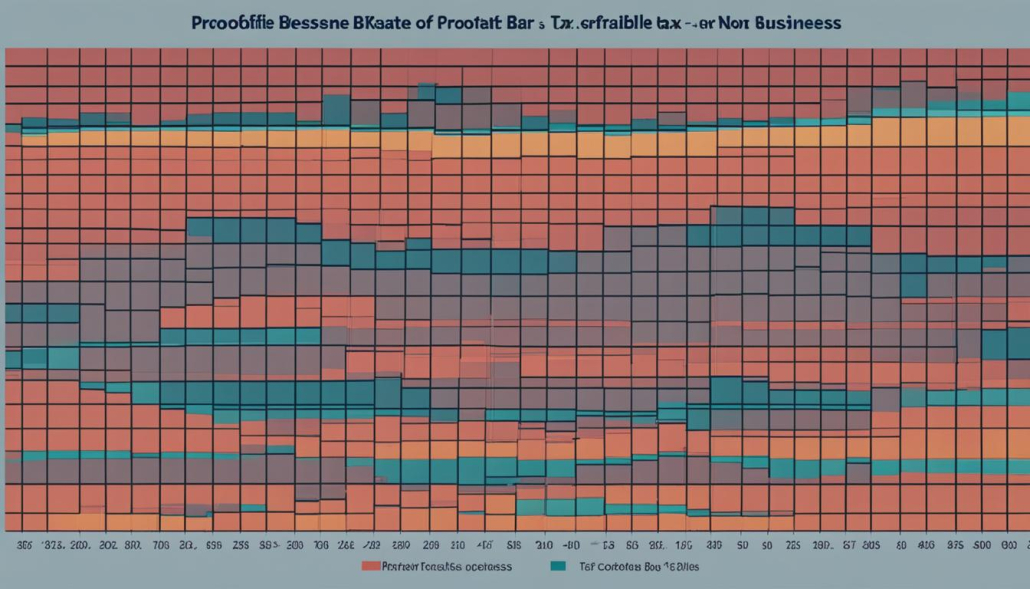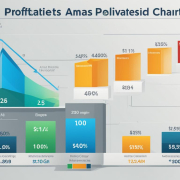Understanding What Is Profit in Business
Profit, the cornerstone of business success, encompasses the financial benefit derived when a company’s revenue surpasses its expenses, costs, and taxes. Our primary goal as businesses is to generate revenue and achieve profitability, making profit a fundamental concept to comprehend.
To calculate profit, subtract the total expenses from the total revenue. This simple equation provides a clear picture of our financial gain. It’s essential to note that profit takes various forms, including gross profit, operating profit, and net profit. These distinctions allow us to evaluate different aspects of our business performance.
Profitability is indispensable for attracting investors and demonstrating the potential for growth and reinvestment. By understanding the intricacies of profit and its calculation, we can equip ourselves with the knowledge and strategies needed to ensure our business’s financial success.
Key Takeaways:
- Profit refers to the financial benefit gained when revenue exceeds expenses, costs, and taxes.
- Gross profit, operating profit, and net profit are the three major types of profit.
- Profitability plays a vital role in attracting investors and facilitating business growth.
- Profit is different from revenue as it reflects the actual financial benefit derived from business operations.
- Measuring and understanding profit is crucial for evaluating business viability and success.
The Types of Profit: Gross, Operating, and Net Profit
In the business world, profit is an essential metric that indicates financial success and sustainability. While the term “profit” is often used broadly, there are three distinct types of profit that play a crucial role in assessing a company’s performance: gross profit, operating profit, and net profit.
Gross Profit
Gross profit is the amount of money a business earns after deducting the cost of goods sold (COGS) from its revenue. COGS includes the direct expenses directly related to the production or acquisition of goods, such as raw materials, manufacturing costs, and direct labor.
Calculating gross profit is relatively straightforward:
Revenue – Cost of Goods Sold = Gross Profit
Gross profit represents the profit generated solely from the production and sale of goods, providing insight into a company’s ability to efficiently manage its production costs and pricing strategies.
Operating Profit
Operating profit, also known as earnings before interest and taxes (EBIT), reflects the profitability of a company’s core business operations. It takes into account not only the cost of goods sold but also the operating expenses required to run the business.
The formula for calculating operating profit is:
Gross Profit – Operating Expenses = Operating Profit
Operating profit represents the profit generated from day-to-day operations, excluding non-operating activities such as interest payments and taxes. It provides a clear picture of a company’s ability to generate profit from its core business activities.
Net Profit
Net profit, often referred to as the “bottom line,” represents the final profit retained by the business after deducting interest expenses and taxes from operating profit.
To calculate net profit, the following formula is used:
Operating Profit – Interest Expenses – Taxes = Net Profit
Net profit is a key indicator of a company’s true financial health as it takes into account all expenses, including the costs associated with debt and taxes. It represents the profit available for distribution to shareholders, reinvestment in the business, or debt repayment.
The table below summarizes the differences between gross profit, operating profit, and net profit:
| Type of Profit | Calculation | Represents |
|---|---|---|
| Gross Profit | Revenue – Cost of Goods Sold | Profit from production and sale of goods |
| Operating Profit | Gross Profit – Operating Expenses | Profit from core business operations |
| Net Profit | Operating Profit – Interest Expenses – Taxes | Final profit retained by the business |
Understanding the different types of profit is essential for analyzing a company’s financial performance comprehensively. Gross profit highlights the profitability of goods production, operating profit provides insights into the core business operations, and net profit reveals the ultimate financial benefit retained by the business.
The Significance of Profit in Business
Profit is of utmost importance in the business world. It serves as a critical indicator of a company’s success and sustainability. By generating profit, businesses not only demonstrate their ability to generate revenue but also attract the attention of potential investors and secure funding for growth and expansion. Profitability is the lifeblood of any business, allowing companies to create value for their shareholders and drive economic growth.
Unlike revenue, which represents the total income generated by a business, profit showcases the true financial benefit derived from its operations. While revenue reflects the size and scale of a business, profit goes beyond mere numbers, illustrating the efficiency and effectiveness of a company’s operations in generating surplus income.
Profit also provides businesses with the flexibility to distribute dividends to shareholders, rewarding their investment and fostering a sense of trust and loyalty. Moreover, profit enables companies to reinvest in their operations, fostering innovation, technological advancements, and expansion into new markets. This reinvestment not only ensures the company’s future success but also contributes to overall economic growth and development.
In the highly competitive business landscape, achieving and maintaining profitability is crucial for business survival. By consistently generating profit, businesses can meet their financial obligations, repay debts, fund projects, and implement strategic initiatives. Profitability also affords companies the opportunity to attract and retain top talent, invest in employee training and development, and foster a positive work environment.
“Profit is not the legitimate purpose of business. Rather, it is the test of its validity.” – Peter Drucker
The Importance of Profit in Business:
- Drives business success and sustainability
- Attracts investors and secures funding for growth and expansion
- Enables value creation for shareholders through dividends and reinvestment
- Indicates operational efficiency and effectiveness
- Supports economic growth and development
- Ensures financial stability and viability
- Allows businesses to meet financial obligations and repay debts
- Fosters innovation, technological advancements, and market expansion
- Cultivates a positive work environment and attracts top talent
Overall, profit forms the foundation of a successful and prosperous business. It serves as a measure of a company’s ability to generate surplus income, attract investors, and create value for shareholders. By prioritizing profitability, businesses can drive growth, ensure financial stability, and navigate the challenges of the dynamic business landscape.
Profit vs. Revenue Comparison
| Aspect | Profit | Revenue |
|---|---|---|
| Definition | The financial benefit derived from a company’s operations when the revenue exceeds expenses, costs, and taxes. | The total income generated by a business from its activities. |
| Indicator | Success, sustainability, and operational efficiency. | Size and scale of the business. |
| Importance | Attracting investors, securing funding, distributing dividends, and reinvesting for growth. | Demonstrating business activity and potential. |
| Long-term Impact | Financial stability, viability, and ability to meet obligations. | Market position and growth opportunities. |
Measuring and Calculating Profit
Profit is a key indicator of a business’s financial performance and viability. By measuring and calculating profit, companies can gain valuable insights into their success and make informed decisions.
To calculate profit, subtract total expenses from total revenue. This straightforward calculation provides a clear picture of how much money the business is making after accounting for costs.
Financial statements, such as the income statement, play a critical role in measuring and tracking profitability. The income statement reflects the revenue generated and the expenses incurred during a specific period, allowing businesses to assess their financial health.
Profitability ratios are another useful tool for evaluating a company’s performance. These ratios compare a business’s profits to its revenue, assets, or equity, providing a benchmark for comparison against industry standards.
Measuring profit is essential for understanding the overall financial health of a business and determining its long-term viability. By closely monitoring profit, companies can identify areas that need improvement and make strategic adjustments to improve their bottom line.
Example:
We calculated the profit for our clothing store by subtracting the total expenses, including rent, employee wages, and inventory costs, from the revenue generated from sales. This allowed us to gauge the financial success of our business and identify areas where we could optimize our operations to increase profitability.
Measuring and calculating profit is an ongoing process that requires regular monitoring and analysis. By understanding the factors that contribute to profit and implementing appropriate strategies, businesses can optimize their financial performance and ensure long-term success.
| Profitability Ratio | Formula | Interpretation |
|---|---|---|
| Gross Profit Margin | (Gross Profit / Revenue) x 100 | Indicates the percentage of revenue retained after accounting for the cost of goods sold. |
| Net Profit Margin | (Net Profit / Revenue) x 100 | Shows the percentage of revenue that translates into net profit after deducting all expenses, including taxes and interest. |
| Return on Assets (ROA) | (Net Profit / Total Assets) x 100 | Measures the efficiency of an organization’s use of its assets to generate profit. |
| Return on Equity (ROE) | (Net Profit / Shareholder’s Equity) x 100 | Evaluates the profitability of a company based on the shareholder’s investment. |
The Origins of Profit
Economists have put forth various theories on where profit originates from. These differing perspectives shed light on the complex nature of profit and its significance in the business world.
Karl Marx’s labor theory of profit:
Karl Marx argued that profit arises from the surplus labor extracted from workers by business owners. According to Marx, profit is the result of exploiting the labor force, as workers are paid less than the value of their labor.
The entrepreneurial risk theory:
Another viewpoint suggests that profit serves as compensation for the risks undertaken by entrepreneurs when starting and operating a business. Entrepreneurs bear the uncertainty and potential losses associated with their ventures and are rewarded with profit when they succeed.
Inefficient markets and imperfect competition:
Some economists argue that profit emerges from inefficient markets and imperfect competition. In these circumstances, businesses can generate excess profit by exploiting market gaps, gaining a competitive advantage, or exercising market power.
Understanding the sources of profit provides valuable insights for analyzing and evaluating the economic and social implications of profitability in business.
The Corporate Tax Rate on Profits
In the United States, the corporate tax rate on profits is currently 21%. This rate was reduced from 35% to 21% with the implementation of the 2017 Tax Cuts and Jobs Act. The corporate tax rate affects the amount of profit that businesses retain after taxes.
When planning their financial strategies and evaluating their overall profitability, companies need to consider the impact of the corporate tax rate. It directly affects the bottom line, as higher tax rates mean businesses retain less profit. This consideration becomes particularly significant as corporate tax rate on profits can have substantial implications on a business’s financial performance and decision-making.
Understanding the corporate tax rate on profits is crucial for accurate financial forecasting, budgeting, and strategic planning. It allows businesses to assess the impact of taxes on their operations and adjust their strategies accordingly to maximize their after-tax profits.
Let’s take a closer look at how the corporate tax rate on profits affects businesses and their overall profitability.
Corporate Tax Rate Comparison
| Tax Rates | Year |
|---|---|
| 35% | Before 2018 |
| 21% | Since 2018 |
The table above provides a comparison of the corporate tax rates on profits in the United States. Prior to 2018, the rate was 35%, but it was significantly reduced to 21% after the implementation of the Tax Cuts and Jobs Act. This reduction aimed to stimulate economic growth, attract investments, and encourage businesses to expand their operations.
By lowering the corporate tax rate on profits, businesses have more capital available for reinvestment, research and development, hiring, and other growth initiatives. It also fosters a competitive environment, allowing businesses to allocate resources more efficiently and remain globally competitive.
Taxation is an integral part of a business’s financial considerations, and the corporate tax rate on profits plays a crucial role in determining the company’s financial performance and competitiveness. It is essential for businesses to continually monitor and evaluate the impact of tax rates on their profitability and adjust their strategies accordingly.
Overall, the corporate tax rate on profits is a significant aspect of financial planning for businesses. It directly affects the bottom line, and understanding its impact enables businesses to make informed decisions about their financial strategies, investments, and growth opportunities.
The Bottom Line and Its Significance
The bottom line is a critical financial metric that reflects a company’s net profit. It represents the ultimate measure of a company’s profitability during a specific period, taking into account all expenses, including interest expenses and taxes. By subtracting these costs from the operating profit, the bottom line reveals how much profit the company has available for various purposes.
An increasing bottom line is a positive sign of company growth and success. It indicates that the business is generating more profit and potentially becoming more efficient in its operations. On the other hand, a shrinking bottom line may raise concerns as it suggests potential issues with the company’s financial performance.
The significance of the bottom line lies in its role as a key determinant of a company’s financial health and future prospects. The profit available in the bottom line can be used for a multitude of purposes, including:
- Dividends: Paying out a portion of the profit to shareholders as a return on their investment.
- Retained Earnings: Reinvesting the profit back into the company for future growth and expansion.
- Debt Payments: Servicing the company’s outstanding debt obligations, increasing its creditworthiness.
- Reinvestment: Allocating funds for research and development, innovation, or other strategic initiatives.
Ultimately, the bottom line showcases a company’s ability to generate profit and effectively manage its financial resources. It serves as a key performance indicator for investors, lenders, and stakeholders, providing insights into the company’s financial stability and prospects for long-term success.
Profitability and Business Survival
Profitability plays a crucial role in the long-term survival of a business. Without profitability, a company will struggle to meet its financial obligations and sustain its operations. Profitability allows businesses to generate the necessary resources for growth and expansion, repay debts, fund projects, and reinvest in the company.
Consistently achieving profitability is an important goal for business managers and owners. It ensures the viability and success of the business in the competitive market. Profitability attracts investors who are looking for profitable ventures to invest their capital. It also gives businesses the ability to weather economic downturns and unexpected challenges, providing a buffer against financial instability.
Businesses that prioritize profitability can implement strategies to improve their financial performance by increasing revenue, reducing expenses, and optimizing their operations. By maximizing profitability, businesses can strengthen their financial position and improve their chances of long-term survival.
The Impact of Profitability on Business Survival
A profitable business is better equipped to weather economic uncertainties and industry disruptions. When a business is profitable, it has the financial means to invest in research and development, adapt to changing market conditions, and stay ahead of competitors. Profitability also allows businesses to attract and retain top talent, invest in training and development programs, and offer competitive compensation packages.
“Profitability is not only about making money; it is about creating a solid foundation for business success and longevity.”
– John Smith, CEO of ABC Corporation
Moreover, profitability provides businesses with the resources to invest in marketing and advertising efforts, expand their customer base, and increase market share. By continuously analyzing and improving profitability, businesses can make informed decisions, set realistic goals, and create effective strategies that contribute to long-term success.
Profitability is not solely about generating revenue; it is about managing costs and optimizing efficiency. Businesses need to identify areas where costs can be reduced without compromising the quality of products or services. By adopting lean practices, streamlining operations, and embracing technological advancements, businesses can improve profitability while delivering value to customers.
Key Factors Affecting Business Profitability
| Factors | Impact on Profitability |
|---|---|
| Revenue Growth | Achieving higher sales and expanding customer base leads to increased revenue and potential profit growth. |
| Cost Control | Efficient management of costs and expenses helps maximize profit margins and overall profitability. |
| Market Position | A competitive advantage and strong market position allow businesses to command higher prices and drive profitability. |
| Operational Efficiency | Optimizing processes and utilizing resources effectively reduces waste and improves overall profitability. |
| Effective Pricing Strategy | Setting appropriate pricing levels to balance profitability and customer demand drives financial success. |
In conclusion, profitability is not just a financial metric; it is a fundamental factor for business survival. It enables businesses to meet their financial obligations, invest in growth opportunities, and navigate through challenges. By prioritizing profitability and implementing effective strategies, businesses can secure their long-term success in the highly competitive business world.
Accounting Methods and Profit Measurement
In order to accurately measure profit, different accounting methods can be utilized. The two main methods include the cash method and the accrual method.
The cash method records income and expenses when cash is received or paid, respectively. This method is commonly used in farming and small businesses where transactions typically occur in real-time. With the cash method, revenue is recognized when payment is received, and expenses are recognized when cash is paid out.
On the other hand, the accrual method records income when products are produced or services are rendered, and expenses when inputs are used or obligations are incurred. It provides a more accurate picture of profitability by considering the timing of revenue and expenses, even if cash has not yet been exchanged. The accrual method is widely used in larger businesses and is required by generally accepted accounting principles (GAAP) for most companies.
Other accounting methods, such as double-entry accounting, can also be employed to measure profit. Double-entry accounting is based on the principle that every transaction affects two accounts, maintaining a balance of debits and credits. This method provides a comprehensive view of financial transactions and enables accurate profit measurement.
Example: Accrual Method vs Cash Method
| Category | Accrual Method | Cash Method |
|---|---|---|
| Revenue | Recognized when products are sold or services are rendered, regardless of cash inflow | Recognized when cash is received |
| Expenses | Recognized when inputs are used or obligations are incurred, regardless of cash outflow | Recognized when cash is paid |
| Timing | Reflects the actual performance period of the business | Reflects cash flow activities and timing |
| Accuracy | Provides a more detailed and accurate representation of financial performance | Provides a simplified view of financial transactions |
By utilizing different accounting methods, businesses can effectively measure their profit and gain insights into their financial performance and position.
Profitability vs Cash Flow
In the world of business, profitability and cash flow are two critical concepts that must be carefully managed and understood. While they are related, they serve distinct purposes and require different considerations. Let’s explore the differences and significance of profitability as compared to cash flow.
Profitability: Maximizing Financial Benefit
Profitability measures the financial benefit gained from business activities. It is calculated by examining the revenue and expenses recorded on the income statement. A profitable business generates more revenue than it incurs in costs and expenses. Profitability is a key indicator of a company’s financial success, attracting investors and enabling growth and expansion.
| Benefits of Profitability | Challenges of Profitability |
|---|---|
|
|
Cash Flow: Managing Liquidity
Cash flow, on the other hand, focuses on the movement of cash in and out of the business. It is assessed through the cash flow statement, which tracks the actual cash flow resulting from operating activities, investing activities, and financing activities. Cash flow management is essential for ensuring that a business has enough liquid assets to cover its short-term obligations.
| Benefits of Cash Flow Management | Challenges of Cash Flow Management |
|---|---|
|
|
It is important to note that a profitable business may still experience cash flow problems if there is a mismatch between when revenue is received and when expenses or liabilities are paid. For example, if a business extends credit to customers, it may record revenue on the income statement but may not receive cash immediately. Similarly, if a business has significant expenses paid in advance, its cash flow may be temporarily reduced even though it remains profitable.
Managing both profitability and cash flow is essential for maintaining a healthy and sustainable business. By identifying potential gaps between profitability and cash flow, businesses can implement strategies to bridge the divide and ensure ongoing financial stability.
In conclusion, profitability signifies the financial success and viability of a business, while cash flow management ensures its day-to-day liquidity. Both aspects are crucial for long-term growth and survival. By carefully balancing profitability and cash flow, businesses can maximize their performance, attract investors, and secure a sustainable future.
Conclusion
Profit is a fundamental concept in business that serves as a key indicator of financial success and long-term viability. By understanding the various types of profit, such as gross, operating, and net profit, businesses can effectively assess their performance and make informed decisions to enhance profitability.
Measuring and maximizing profit through effective financial management strategies is crucial for achieving sustainable growth and survival in the competitive market. Businesses need to carefully track and analyze their revenue and expenses, optimize operational efficiency, and identify ways to reduce costs and increase revenues.
Profitability remains a top priority for businesses as it not only attracts investors and stakeholders but also supports business expansion and ensures the overall success of the enterprise. By consistently focusing on maximizing profit, businesses can strengthen their financial position, reinvest in their operations, and secure a prosperous future.
FAQ
What is profit?
Profit refers to the financial benefit that a business gains when the revenue generated from its activities exceeds the expenses, costs, and taxes involved.
What are the types of profit?
The types of profit include gross profit, operating profit, and net profit.
Why is profit important in business?
Profitability is crucial for business success as it attracts investors and allows for growth and reinvestment.
How is profit calculated?
Profit is calculated by subtracting total expenses from total revenue.
Where does profit come from?
Economists have different theories on the origin of profit, including surplus labor, compensation for risk, and market inefficiencies.
What is the corporate tax rate on profits in the US?
The corporate tax rate on profits in the US is currently 21%.
What is the significance of the bottom line?
The bottom line represents the net profit of a company and indicates its ultimate profitability.
How does profitability relate to business survival?
Profitability is crucial for the long-term survival of a business as it allows for growth, debt repayment, and reinvestment.
What are the different accounting methods used to measure profit?
The cash method and the accrual method are commonly used to measure profit, among other accounting methods.
How does profitability differ from cash flow?
Profitability measures the financial benefit gained from business activities, while cash flow focuses on the movement of cash in and out of the business.
Source Links
- https://www.investopedia.com/terms/p/profit.asp
- https://www.extension.iastate.edu/agdm/wholefarm/html/c3-24.html
- https://www.xero.com/us/glossary/profit/
- About the Author
- Latest Posts
Claudia is a senior content writer with an insatiable wanderlust and a passion for exploring the world of business. Armed with a pen and a laptop, she roams the globe, capturing the essence of diverse cultures while delving into a myriad of business-related subjects.










